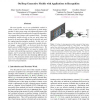Free Online Productivity Tools
i2Speak
i2Symbol
i2OCR
iTex2Img
iWeb2Print
iWeb2Shot
i2Type
iPdf2Split
iPdf2Merge
i2Bopomofo
i2Arabic
i2Style
i2Image
i2PDF
iLatex2Rtf
Sci2ools
CVPR
2011
IEEE
2011
IEEE
On Deep Generative Models with Applications to Recognition
The most popular way to use probabilistic models in vision is first to extract some descriptors of small image patches or object parts using well-engineered features, and then to use statistical learning tools to model the dependencies among these features and eventual labels. Learning probabilistic models directly on the raw pixel values has proved to be much more difficult and is typically only used for regularizing discriminative methods. In this work, we use one of the best, pixel-level, generative models of natural images – a gated MRF – as the lowest level of a deep belief network (DBN) that has several hidden layers. We show that the resulting DBN is very good at coping with occlusion when predicting expression categories from face images, and it can produce features that perform comparably to SIFT descriptors for discriminating different types of scene. The generative ability of the model also makes it easy to see what information is captured and what is lost at each lev...
Related Content
| Added | 05 Apr 2011 |
| Updated | 29 Apr 2011 |
| Type | Journal |
| Year | 2011 |
| Where | CVPR |
| Authors | Marc', Aurelio Ranzato, Joshua Susskind, Volodymyr Mnih, Geoffrey Hinton |
Comments (0)

